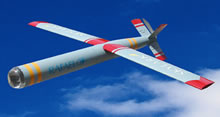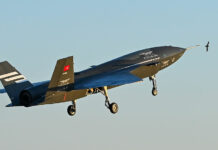The Skylite is designed as an organic imaging intelligence collection system for combat elements, providing real-time, “over the hill” intelligence and force protection coverage for deployed tactical units, up to battalion level, including special-forces, dismounted infantry, and mechanized or armored formations. Skylite is designed for combat support missions, providing real-time intelligence and force protection for combat formations.
The system offers unique advantages in urban terrain (MOUT) where a team of two operators can carry two ready to launch MAVs and a control station. The Skylite offers flexible, unrestricted launch envelope, including firing from within bunkers, closed rooms, rooftops or narrow streets. Skylite can fly a mission of 60 – 90 minutes, with a mission radius of 5,000 – 10,000 meters. The Skylite maintains a relatively high speed, to withstand gusts and high crosswinds, and operate in difficult weather conditions. The fuselage is a 110 cm long, 12cm diameter tube, with a forward looking EO payload mounted at the nose. Following launch, the Skylite’s wings (1.5m wingspan) and cruciform tail snap into flight position, powered by electrical motors. The retrievable drone is equipped with a stabilized camera that provides wide area coverage and point-of-interest monitoring. The Skylite is designed for simple operation at the tactical field level of infantry, mechanized and armor units. It does not require any specialized support, coordination with air control or communications facilities. Skylite is stored in a lightweight container (2 kg) which also provides a launcher for the MAV. The gross weight of the MAV is 6 kg. All pre-launch settings are performed automatically and do not require any operator involvement. The reusable MAV is handled as a “wooden round”, and requires zero logistics for storage or operation. At the end of the mission it is retrieved automatically into a net, and is being reconditioned and repacked into the launchers at the battalion level.
 Handled as a maintenance free “wooden round”, the system requires “zero time to launch” – without any assembly or pre-launch preparations. It is launched from a lightweight, man portable canister which uses a small rocket booster to accelerate the MAV to its cruising speed and altitude. This method enables an automatic launch of the MAV by remote control, from within a tank or APC, or manually deployment as a “shoulder fired missile”, from enclosed spaces such as rooms, bunkers and from narrow streets in crowded urban settings. The boosted launch accelerates the Skylite to its cruise speed and therefore overcomes difficult launch conditions, and high crosswind, thus enabling the forward troops a dependable and reliable visibility “around the corner”.
Handled as a maintenance free “wooden round”, the system requires “zero time to launch” – without any assembly or pre-launch preparations. It is launched from a lightweight, man portable canister which uses a small rocket booster to accelerate the MAV to its cruising speed and altitude. This method enables an automatic launch of the MAV by remote control, from within a tank or APC, or manually deployment as a “shoulder fired missile”, from enclosed spaces such as rooms, bunkers and from narrow streets in crowded urban settings. The boosted launch accelerates the Skylite to its cruise speed and therefore overcomes difficult launch conditions, and high crosswind, thus enabling the forward troops a dependable and reliable visibility “around the corner”.
The Skylite is an autonomous vehicle, which follows a pre-preplanned flight program or a loitering pattern, when it waits for new tasking orders. The mission plan is designated by the user on a laptop, where points of interest are pointed on a digital map or aerial photo. The Skylite follows these points of interest and can maintain constant view of specific point of interest from various viewing angles or from a specific direction. The operator can also control the gimbaled payload, to focus on specific points of interest. The payload can employ a color camera, night camera or lightweight infrared camera. It is designed to detect, identify and track targets at a size of an armed human, from a range of 100 – 300 meters. The images received from the Skylite can be displayed on the laptop, or relayed to forward commanders and displayed on their palmtop PCs.

















